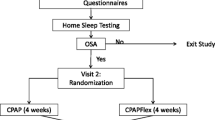Summary
Question of the study
Compliance with nasal continuous positive airway pressure (nCPAP) treatment may be reduced due to difficulties when exhaling against a positive pressure. A recently introduced CPAP system therefore lowers the expiratory pressure proportional to the patient's airflow. To evaluate the theoretical concern that this might induce, flow limitations during inspiration, we measured the occurrence of flow limitation during sleep.
Patients and methods
Eight subjects with treated obstructive sleep apnoea were studied with polysomnography including respiratory flow and oesophageal pressure measurement. Conventional CPAP and three settings of the new system were applied in a randomised order during both NREM and REM sleep. Two approaches for measuring inspiratory flow limitation were used: oesophageal pressure and respiratory resistance.
Results
Using the oesophageal pressure criterion, 3.5% of breaths during CPAP mode were flow limited as compared to 1.4% during the new mode. Flow limitations using the novel criterion of respiratory resistance, we counted 13.6% of flow-limited breaths during CPAP mode and 10.1% during the new mode. Equivalence testing confirmed equivalence between the novel system and CPAP.
Conclusions
The results confirm that there is no increase in the number of flow limitations during the new mode as compared to CPAP.
Zusammenfassung
Fragestellung
Manche Patienten klagen darüber, dass es für sie problematisch ist, gegen einen kontinuierlichen positiven Druck bei der CPAP-Therapie auszuatmen. Möglicherweise reduziert diese Problematik die Compliance der Patienten. Ein kürzlich eingeführtes CPAP-System senkt während der Exspiration den Druck proportional zum vom Patienten generierten Atemfluss ab. Ein Kritikpunkt dieser exspiratorischen Druckabsenkung ist, dass sie eventuell inspiratorische Flusslimitationen induzieren kann. Um diesen Aspekt zu klären, untersuchten wir das Auftreten von inspiratorischen Flusslimitationen während des Schlafs.
Patienten und Methodik
An dieser Studie nahmen 8 Patienten mit mittels CPAP-Therapie behandelten schlafbezogenen Atmungsstörungen teil. Alle 8 Patienten unterzogen wir einer kompletten Polysomnographie inklusive inspiratorischer Flussmessung und Ösophagusdruckmessung. Eine konventionelle CPAP-Therapie und alle 3 Modi der neuen Therapie mit exspiratorischer Druckabsenkung wurden in randomisierter Reihenfolge während NREM und REM-Schlaf appliziert. Zur Erfassung von inspiratorischen, Flusslimitationen wurden 2 verschiedene Verfahren genutzt: der Ösophagusdruck und die Messung der respiratorischen Resistance.
Ergebnisse
Mit dem Ösophagusdruckkriterium wurden 3,5% der Atemzüge unter konventioneller CPAP-Therapie und 1,4% unter Therapie mit exspiratorischer Druckabsenkung als flusslimitiert gewertet. Sowohl im NREM- als auch im REM-Schlaf war die Zahl der Flusslimitationen unter Therapie mit exspiratorischer Druckabsenkung signifikant reduziert. Erfasst mit der Methode der respiratorischen Resistance war der Anteil flusslimitierter Atemzüge höher: 13,6% während konventioneller CPAP-Therapie und 10,1% während der Therapie mit exspiratorischer Druckabsenkung. Die Äquivalenztestung bestätigte Äquivalenz zwischen der Therepie mit exspiratorischer Druckabsenkung und der konventionellen CPAP-Therapie.
Schlussfolgerung
Diese Ergebnisse zeigen, dass eine exspiratorische Druckabsenkung im getesteten System nicht zum Auftreten zusätzlicher inspiratorischer Flusslimiationen führt.
Similar content being viewed by others
References
Atlas Task Force ASDA: EEG arousals: scoring rules and examples. Sleep 15: 173–184, 1992.
Ayappa I, Norman RG, Hosselet JJ, Gruenke RA, Walsleben JA, Rapoport DM: Relative occurrence of flow limitation and snoring during continuous positive airway pressure titration. Chest 114: 685–690, 1998.
Bijaoui E, Tuck SA, Remmers JE, Bates JH: Estimating respiratory mechanics in the presence of flow limitation. J Appl Physiol 86: 418–426, 1999.
Condos R, Norman RC, Krishnasamy I, Peduzzi N, Goldring RM, Rapoport DM: Flow limitation as a noninvasive assessment of residual upper-airway resistance during continuous positive airway pressure therapy of obstructive sleep apnea. Am J Respir Crit Care Med 150: 475–480, 1994.
Guilleminault C, Stoohs R, Clerk A, Cetel M, Maistros P: A cause of excessive daytime sleepiness: the upper airway resistance syndrome. Chest 104: 781–787, 1993.
Guilleminault C, Stoohs R, Clerk A, Simmons J, Labanowski M: From obstructive sleep apnea syndrome to upper airway resistance syndrome: consistency of daytime sleepiness. Sleep 15: S13-S16, 1992.
Guilleminault C, Stoohs R, Duncan S: Snoring (I). Daytime sleepiness in regular heavy snorers. Chest 99: 40–48, 1991.
Juhasz J, Becker H, Cassel W, Rostig S, Peter JH: Proportional positive airway pressure: a new concept to treat obstructive sleep apnoea. Eur Respir J 17: 467–473, 2001.
Lorino AM, Maza M, D'Ortho MP, Coste A, Haft A, Lorino H: Effects of mandibular advancement on respiratory resistance. Eur Respir J 16: 928–932, 2000.
Montserrat JM, Ballester E, Olivi H, Reolid A, Lloberes P, Morello A, et al.: Time-course of stepwise CPAP titration. Behaviour of respiratory and neurological variables. Am J Respir Crit Care Med 152: 1854–1859, 1995.
O'Malley EB, Walsleben JA, Norman RG et al.: Detection of unappreciated respiratory-related EEG arousals [abstract]. Am J Respir Crit Care Med 153: A568, 1996.
Philip P, Stoohs R, Guilleminault C: Sleep fragmentation in normals: a model for sleepiness associated with upper airway resistance syndrome. Sleep 17: 242–247, 1994.
Rechtschaffen A, Kales A: A Manual of Standardized Terminology: Techniques and Scoring System for Sleep Stages of Human Subjects. UCLA Brain Information Service/Brain Research Institute, Los Angeles, 1968.
Series F, Marc I: Effects of inspiratory and expiratory positive pressure difference on airflow dynamics during sleep. J Appl Physiol 85: 1855–1862, 1998.
Series F, Straus C, Demoule A, Attali V, Arnulf I, Derenne JP, et al. Assessment of upper airway dynamics in awake patients with sleep apnea using phrenic nerve stimulation, Am J Respir Crit Care Med 162: 795–800, 2000.
Stoohs R, Guilleminault C: Obstructive sleep apnea syndrome or abnormal upper airway resistance during sleep? J Clin Neurophysiol 7: 83–92, 1990.
Sullivan CE, Issa FG, Berthon-Jones M, Eves L: Reversal of obstructive sleep apnoea by continuous positive airway pressure applied through the nares. Lancet 1: 862–865, 1981.
Thurnheer R, Wraith PK, Douglas NJ. Influence of age and gender on upper airway resistance in NREM and REM sleep. J Appl Physiol 90: 981–988, 2001.
Author information
Authors and Affiliations
Corresponding author
Rights and permissions
About this article
Cite this article
Jerrentrup, A., Canisius, S., Kesper, K. et al. Inspiratory flow limitation: Comparison of the C-flex system versus conventional therapy—A pilot study. Somnologie 10, 61–66 (2006). https://doi.org/10.1007/j.1439-054X.2006.00087.x
Issue Date:
DOI: https://doi.org/10.1007/j.1439-054X.2006.00087.x




